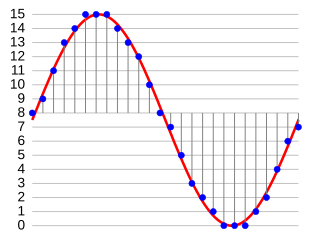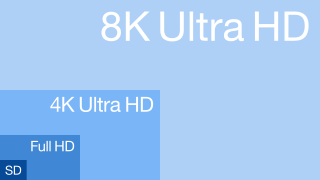A codec is a device or computer program that encodes or decodes a data stream or signal. Codec is a portmanteau of coder/decoder.
Adaptive Transform Acoustic Coding (ATRAC) is a family of proprietary audio compression algorithms developed by Sony. MiniDisc was the first commercial product to incorporate ATRAC, in 1992. ATRAC allowed a relatively small disc like MiniDisc to have the same running time as CD while storing audio information with minimal perceptible loss in quality. Improvements to the codec in the form of ATRAC3, ATRAC3plus, and ATRAC Advanced Lossless followed in 1999, 2002, and 2006 respectively.

G.711 is a narrowband audio codec originally designed for use in telephony that provides toll-quality audio at 64 kbit/s. It is an ITU-T standard (Recommendation) for audio encoding, titled Pulse code modulation (PCM) of voice frequencies released for use in 1972.

1080p is a set of HDTV high-definition video modes characterized by 1,920 pixels displayed across the screen horizontally and 1,080 pixels down the screen vertically; the p stands for progressive scan, i.e. non-interlaced. The term usually assumes a widescreen aspect ratio of 16:9, implying a resolution of 2.1 megapixels. It is often marketed as Full HD or FHD, to contrast 1080p with 720p resolution screens. Although 1080p is sometimes referred to as 2K resolution, other sources differentiate between 1080p and (true) 2K resolution.
Α video codec is software or a device that provides encoding and decoding for digital video, and which may or may not include the use of video compression and/or decompression. Most codecs are typically implementations of video coding formats.
The following is a list of H.264/MPEG-4 AVC products and implementations.
AVC-Intra is a type of video coding developed by Panasonic, and then supported in products made by other companies. AVC-Intra is available in Panasonic's high definition broadcast products, such as, for example, their P2 card equipped broadcast cameras.

aptX is a family of proprietary audio codec compression algorithms owned by Qualcomm, with a heavy emphasis on wireless audio applications.
High Efficiency Video Coding (HEVC), also known as H.265 and MPEG-H Part 2, is a video compression standard designed as part of the MPEG-H project as a successor to the widely used Advanced Video Coding. In comparison to AVC, HEVC offers from 25% to 50% better data compression at the same level of video quality, or substantially improved video quality at the same bit rate. It supports resolutions up to 8192×4320, including 8K UHD, and unlike the primarily 8-bit AVC, HEVC's higher fidelity Main 10 profile has been incorporated into nearly all supporting hardware.

VP9 is an open and royalty-free video coding format developed by Google.
Apple ProRes is a high quality, "visually lossless" lossy video compression format developed by Apple Inc. for use in post-production that supports video resolution up to 8K. It is the successor of the Apple Intermediate Codec and was introduced in 2007 with Final Cut Studio 2. Much like the H.26x and MPEG standards, the ProRes family of codecs use compression algorithms based on the discrete cosine transform (DCT). ProRes is widely used as a final format delivery method for HD broadcast files in commercials, features, Blu-ray and streaming.
High Efficiency Video Coding implementations and products covers the implementations and products of High Efficiency Video Coding (HEVC).
Nvidia NVENC is a feature in Nvidia graphics cards that performs video encoding, offloading this compute-intensive task from the CPU to a dedicated part of the GPU. It was introduced with the Kepler-based GeForce 600 series in March 2012.

Ultra-high-definition television today includes 4K UHD and 8K UHD, which are two digital video formats with an aspect ratio of 16:9. These were first proposed by NHK Science & Technology Research Laboratories and later defined and approved by the International Telecommunication Union (ITU).
Display Stream Compression (DSC) is a VESA-developed video compression algorithm designed to enable increased display resolutions and frame rates over existing physical interfaces, and make devices smaller and lighter, with longer battery life. It is a low-latency algorithm based on delta PCM coding and YCGCO-R color space.
JPEG XL is a royalty-free raster-graphics file format that supports both lossy and lossless compression. It is designed to outperform existing raster formats and thus become their universal replacement.
Versatile Video Coding (VVC), also known as H.266, ISO/IEC 23090-3, and MPEG-I Part 3, is a video compression standard finalized on 6 July 2020, by the Joint Video Experts Team (JVET), a joint video expert team of the VCEG working group of ITU-T Study Group 16 and the MPEG working group of ISO/IEC JTC 1/SC 29. It is the successor to High Efficiency Video Coding. It was developed with two primary goals – improved compression performance and support for a very broad range of applications.
JPEG XS is an interoperable, visually lossless, low-latency and lightweight image and video coding system used in professional applications. Applications of the standard include streaming high quality content for virtual reality, drones, autonomous vehicles using cameras, gaming, and broadcasting. It was the first ISO codec ever designed for this specific purpose. JPEG XS, built on core technology from both intoPIX and Fraunhofer IIS, is formally standardized as ISO/IEC 21122 by the Joint Photographic Experts Group with the first edition published in 2019. Although not official, the XS acronym was chosen to highlight the eXtra Small and eXtra Speed characteristics of the codec. Today, the JPEG committee is still actively working on further improvements to XS, with the second edition scheduled for publication and initial efforts being launched towards a third edition.




